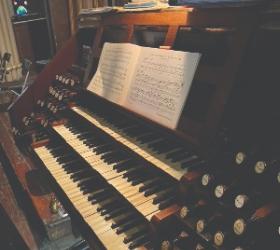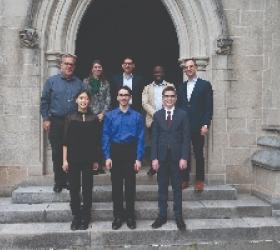
Charles M. Ruggles, Conifer, Colorado
Henry Kilgen, 1884
St. Augustine’s Cultural Center, Austin, Nevada
Charles M. Ruggles of Conifer, Colorado, recently completed the restoration of the Henry Kilgen organ of 1884 in the former St. Augustine’s Catholic Church, Austin, Nevada, now St. Augustine’s Cultural Center. A one-manual, nine-rank instrument, it is the only known extant instrument by Henry that is mechanically, tonally, and visually intact. The Kilgen family of St. Louis, Missouri, were organbuilders; Henry worked independently of his more well-known father, George, from 1882 into the 1910s. The organ is of tracker action in a Victorian Gothic case in the rear gallery, now fitted with an electric blower for convenience in playing.
The church was closed and the parish disbanded in 1990 by the Diocese of Reno due to several factors, including declining population after the county seat was transferred from Austin to Battle Mountain in 1979. Austin, once a large silver mining community founded in 1862, with some 10,000 residents at its peak, was rivalled only by Virginia City, Nevada, home to numerous gold and silver strikes, primarily the Comstock Lode. The town gradually declined in population after the 1880s and today has about 350 residents.
The decaying building was purchased in 2003 by a group of local citizens, led by Jan Morrison, who created a non-profit organization to save and restore the former church. They spent the next ten years applying for and receiving preservation grants totalling some $1 million, resulting in a variety of substantial repairs, including a new roof, steeple and wall repairs, foundation stabilization, interior refurbishing, ADA accessibility, and the like. The organ had been unplayable since the 1960s and was damaged, but intact.
Ruggles was awarded the contract in May 2012 and completed the bulk of the restoration work in October 2013, when the organ was reinstalled. The last phase of the building repairs and refurbishing was not completed, however, due to the scarcity of contractor labor, until the summer of 2014. (Austin is about 170 miles east of Reno on U.S. 50, the so-called “Loneliest Highway in America,” and most construction work is necessarily “trucked in.”) Accordingly, he returned to finish regulating and tuning the organ when the structure was ready.
The center was dedicated in a gala ceremony on September 27, 2014, including an open house, historical lectures, panel discussions, musical presentations, “silent auction,” and an organ recital by Michael Friesen of Denver, Colorado. It is intended to be a place where everything from concerts to art classes and exhibitions, and meetings to a “writer’s oasis” could occur, among the quiet beauty of the historic town and the adjoining Toiyabe Mountains. Unlike many other small towns in the West in the nineteenth century, there was no “Opera House” in Austin, so the center actually serves a unique function for the community.
Austin had at one time three pipe organs, also including one of 1866 by Joseph Mayer of San Francisco in the Methodist Church (unfortunately destroyed) and another of 1878 by Alexander Mills of New York City in St. George’s Episcopal Church (extant). The Kilgen has been awarded recognition as a “National Heritage Pipe Organ” of historical importance by the Organ Historical Society. Being in a small town, both pipe organs are “accessible” to visitors and can be seen and played by organists who pass through, either by advance arrangement (preferable), or by asking a citizen or store proprietor along Main Street to help direct them to someone having a key.
—Michael Friesen
Henry Kilgen, St. Louis, Missouri, 1884
Restoration: Charles M. Ruggles, Conifer, Colorado, 2013
1 manual, 12 drawknobs, 9 speaking stops, 10 registers, 9 ranks, 491 pipes
Mechanical action throughout
Compasses: Manual, 61 notes, C to c4; Pedal, 27 notes, C to d1
Manual (enclosed, except faНade pipes and four unison basses)
[8′] Open Diapason 61 pipes
[8′] Unison Bass 12
[8′] Stop Diapason [tc] 49
[8′] Melodia [tc] 49
[8′] Dulciana [tc] 49
[4′] Principal 61
[4′] Flute Harmonic 61
[22⁄3′] Twelfth 61
[2′] Fifteenth 61
Pedal (unenclosed, at rear)
16′ Bourdon 27
Mechanicals
Pedal Coupler (drawknob)
Pedal Check (drawknob)
Piano Combination Pedal (foot lever, unlabeled)
Forte Combination Pedal (foot lever, unlabeled)
Expression Pedal
Note: The drawknobs for the manual stops do not give the pitches, but they are supplied here in conventional form for convenience.




